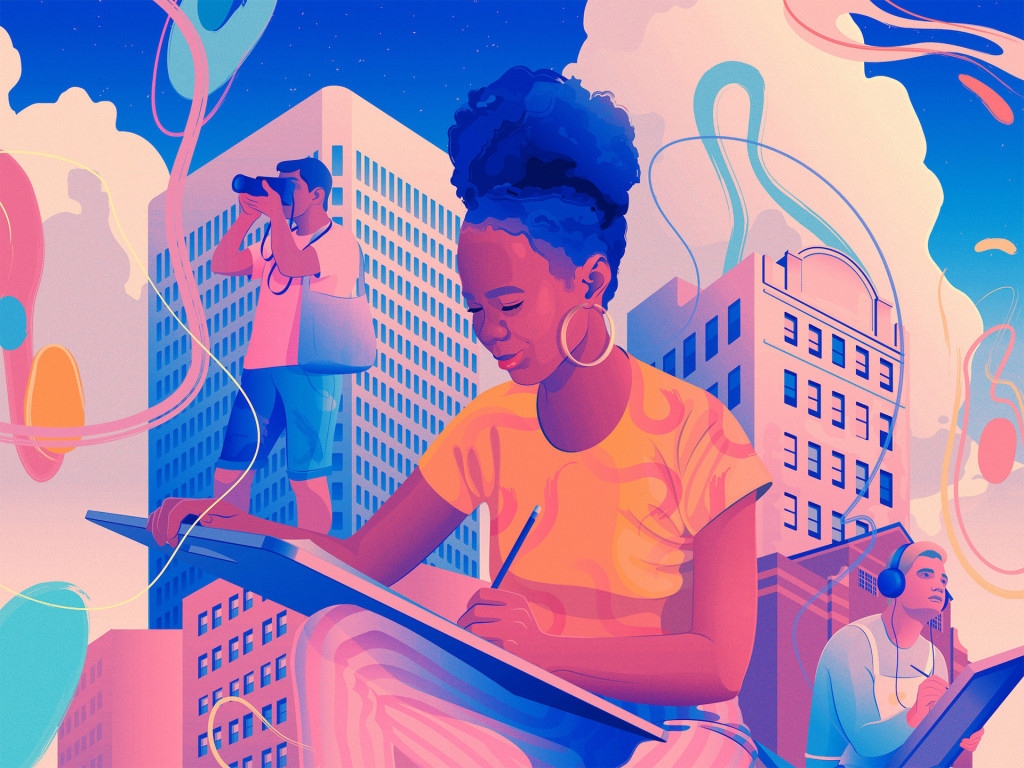Kids and adults are becoming more and more techno-savvy, especially kids who are used to all kinds of gadgets from a very small age. Taking it into account and seeing how many educational solutions are there on the market already, it makes sense that the process of e-learning app design is getting harder. What’s important is to pay special attention to where those principles differ, affected by the intricacies of apps for studying and teaching.
What does it mean to you as a designer or an owner of an e-learning business? To captivate your target audience, it’s best to tailor your designs to the specific needs of your users, those who study as well as those who teach, considering what challenges educational products can present, and analyzing the competitors.
Let’s discuss in what ways UI/UX design is important in e-learning app development and how to make a learning app using some of the best practices of mobile app design to unlock the full potential of e-learning apps.
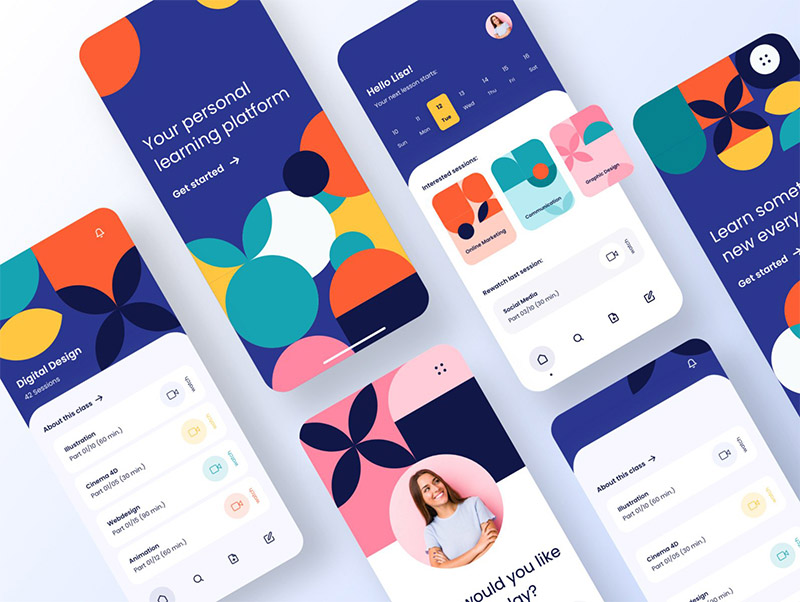
Learning Platform | Mobile Design by Lukas Rudrof
Types of e-learning apps
The current state of the education industry was greatly affected by the rise of the pandemic showing that only those educators who recognize the power of online learning have a chance to succeed and stay afloat. E-learning applications are not only a useful tool that simplifies the lives of students and teachers and satisfies the need for education in a convenient way, but they also present a tremendous set of business opportunities. The tricky part of education app design is to devise an experience that solves a problem, inspires, and captivates.
Before understanding the challenges connected with e-learning mobile app development, it’s useful to get reminded of the main reason they exist at all. It’s the sheer diversity of learning apps. There are mobile encyclopedias, language learning apps, apps for teachers, apps for learning specific skills like drawing, apps for kids, apps for online courses, apps for exam preparation… You name it. If there’s a skill or a piece of knowledge, there’s an app for that. Why does it matter? It’s this versatility that makes a designer’s job hard. But not impossible.
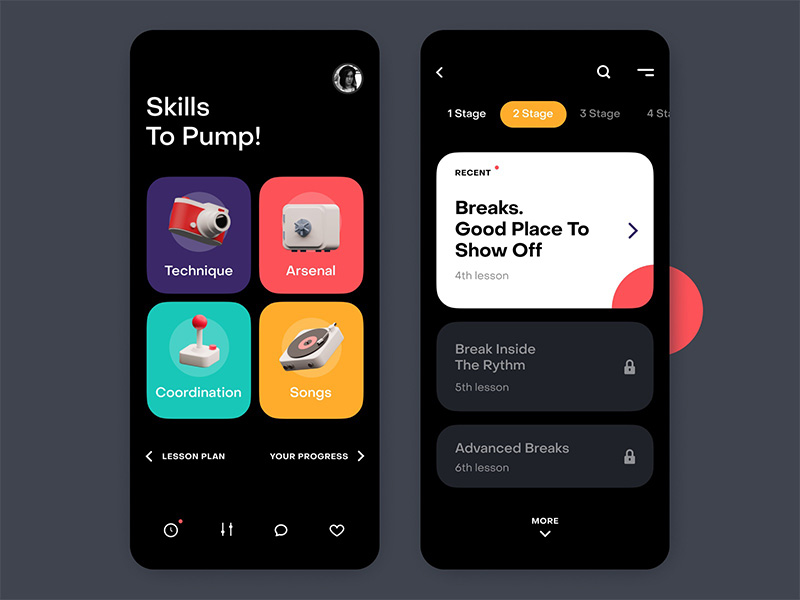
Drums Lessons App by Lina Mielez
How to design mobile apps for learning
There are a number of reasons why a startup can fail. Mediocre content, ineffectual monetization strategy, or insufficient market research are among them. But it’s not just about that. There’s also the importance of app design in educational app development. The main idea is to design an e-learning app so that students would be engaged, spend as much time as possible using an app, and achieve their goals. Great UI and UX can get you that and separate your product from the mass of other apps whose developers failed to pay sufficient attention.
There’s a possibility that an app would end up:
- Unrelatable
- Unclear
- Too complicated
- Inappropriate
- Too time-consuming
- Confusing
- Inconvenient
- Inefficient
- Boring
- Inconsistent and failing to bring value.
Let’s look at each of these possibilities and ways to avoid them using the best practices of mobile app design.
Design based on user psychology
Having determined the type of app you are going to design, the next step is to research the target audience and their preferences: who will use the app, in what ways, when, and to achieve what results. In other words, what is it that is likely to keep them engaged? Using user personas and studying similar apps and reviews can help you with that.
However, while some of your target audience’s specificities may differ greatly, there are some psychological principles that are the same for the majority of people and that can be used in educational app development to create an engaging product. For example, in the case of a learning app, it’s useful to think about it as a person’s new future habit. For that, you need to design experiences that are simple, give incentives, design microsessions, add triggers, and play on FOMO (Fear of Missing Out). The last trick, for instance, is heavily used by every major social media app.
Don’t forget about visual tricks like colors and fonts. Warm tones such as red, orange, and yellow are the optimal colors for retaining learners’ attention and stimulating active involvement. As for the text, just like in a physical exercise book, it should be readable and easy to grasp. At the same time, keep your creative genius at bay: too many bright colors or intricate fonts can push your users away. Even if the educational app looks fine to you, remember that people might have different behaviors and special powers, like color blindness.

Educational Mobile App UI Kit by Nimasha Perera
Design for perspective
In developing educational apps, another key is to add progress indicators at every step. Psychologically, it’s very important for a person to have a notion about the educational path, at what point they are situated at the moment, and what awaits them in the future. Such indicators keep students focused, ready for the next lessons, allow them to complete the course on time, provide a sense of achievement, and encourage them to keep using an app. If the process is unclear, they may become disappointed and stop using an app altogether.
Let users know:
- How many steps they have made.
- How many course materials are still there to accomplish.
- How much time has passed since they started.

Toki – Your Course by NestStrix
Design for educators
One of the challenges that the pandemic has presented the educational industry is not only the universal transition to studying from home and associated technological challenges but the necessity for teachers to embrace the new approaches, to which they were previously unaccustomed. It’s not that modern teachers are not familiar with current technologies, it’s just because of the inertia that sometimes is present at some of the schools, universities, and coaching centers, many of the teachers are used to traditional teaching tools that include blackboards, textbooks, charts, pictures, etc.
So it’s better to implement in your educational app design some of the concepts and logic familiar to educators. That way, they won’t be overwhelmed with new tech and focus on teaching instead, planning innovative teaching strategies from the contents of new apps, and using them to digitize and simplify the educational process.
For example, even the simple and well-known Evernote note-taking app makes the short list of apps that educators find to be the most useful. It lets teachers replace those lengthy printed notes with digital notes in various formats including audio, videos, PDFs, and more.
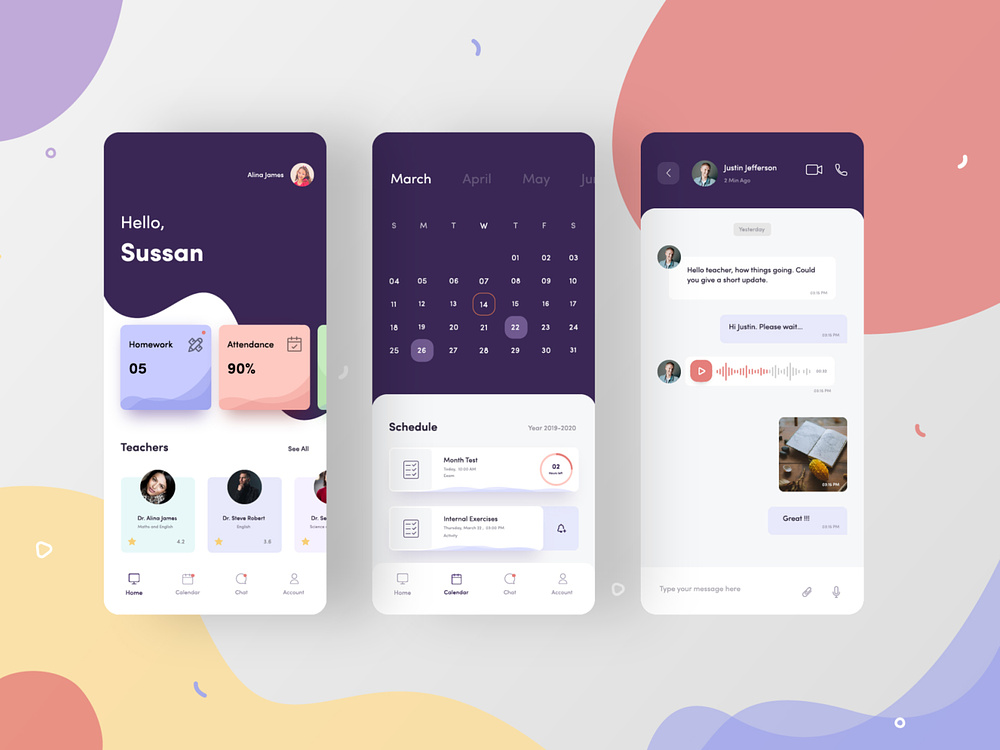
Teachers and Parents App by Rameez Remy
Design for the right age
One of the challenges of educational apps is that they encompass users that vary greatly in age — from toddlers to elderly people. To demonstrate how important this characteristic is, I’d like to point out one of the examples of educational apps that we at Shakuro have designed. It‘s the Cat’n’Clever app that is intended precisely for small children. We used bright colors, illustrations of cute animals, and lots of animations to make the app relatable to small kids.

Cat’n’Clever app
On the other hand, in designing the Proko and CGMA art learning platforms for adults, we aimed at making a totally different impression. The cool and clean, professional-looking, and minimalistic design was used to emphasize the learning approach of those platforms and present the content in the best way possible without creating distractions.
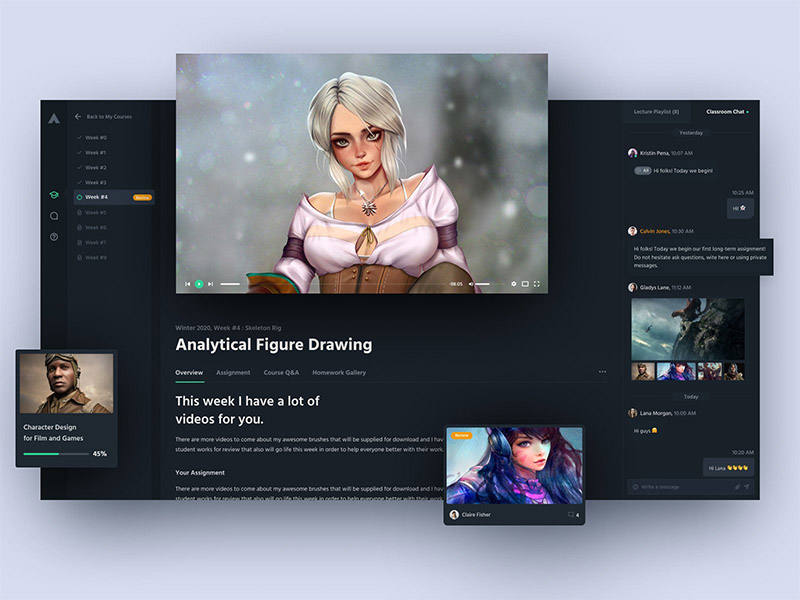
CGMA Website Design by Shakuro
Design for microlearning
Traditional education doesn’t cut it when it comes to the realities of modern life. Though there are a lot of online courses that facilitate access to learning materials, the majority of educational approaches based on the traditional methods with the determined time and place to study are hard to incorporate additionally into the lives of people who already have jobs or other kinds of learning activities that take the majority of their time.
When imagining how the majority of people would use mobile phones for educational purposes in reality, probably the most common situation would be for them to study in short bursts on the go, similar to them using their phones for other kinds of activities like checking the Facebook feed — while commuting, taking their breakfasts, waiting in traffic jams — in other words, between other activities. People are less likely to spend hours on the phone diligently following the curriculum.
According to a study published in the Journal of Applied Psychology, microlearning is 17% more efficient in spreading knowledge than traditional classroom training. The ability to choose your own environment, time, and place for studying is what makes e-learning so attractive. So the ideal way would be to adjust your e-learning app design for microlearning. For that, you need to add small instructional videos, enable flashcard learning, propose to solve mini-training quizzes, and send small bits of information via notifications, email, etc.
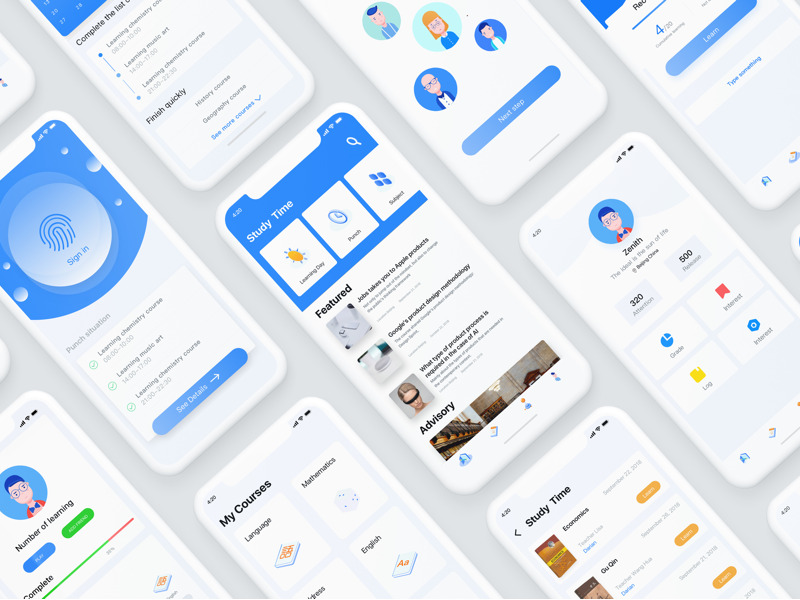
Micro-learning Interface Design by Zenith
Design for minimalism
While using web-based educational platforms, many people prefer them to be packed with as much functionality as possible, the situation is different with mobile solutions where the screens are too small to conveniently hold too many options. This way a feature that was praised on the web becomes a drawback in the case of mobile apps. Hick’s Law explains why too much choice can be a bad thing after all.
So it’s best to minimize your ideas and while not banishing the spectrum of features altogether, limit them to a certain number of essentials present at one time. Less functionality in one go means simpler interfaces with straightforward navigation from one lesson to another.
It’s important to strike a balance between the number of features and usability. Minimalism is reigning today so use it to your advantage.

Online Learning Platform by Imran Hossain
Designing for clarity and convenience
The e-learning app design, no matter how many features it has, can be obvious and understandable to a designer but completely impenetrable to a user, especially to one who is not used to it at all. That’s why it is best to distinguish between which features and learning materials are necessary and which are superfluous and can be put away for the time being.
Make your app clear:
- Provide instructions on how to use your app.
- Keep all the navigational elements consistent throughout the app.
- Make sure that users understand the course objectives.
- Break the learning material down into blocks.
Designing an e-learning solution for mobile, it’s important to concentrate on presenting the key features and content without adding too much noise that can potentially distract users from pursuing their objectives. Even if an app is for kids.
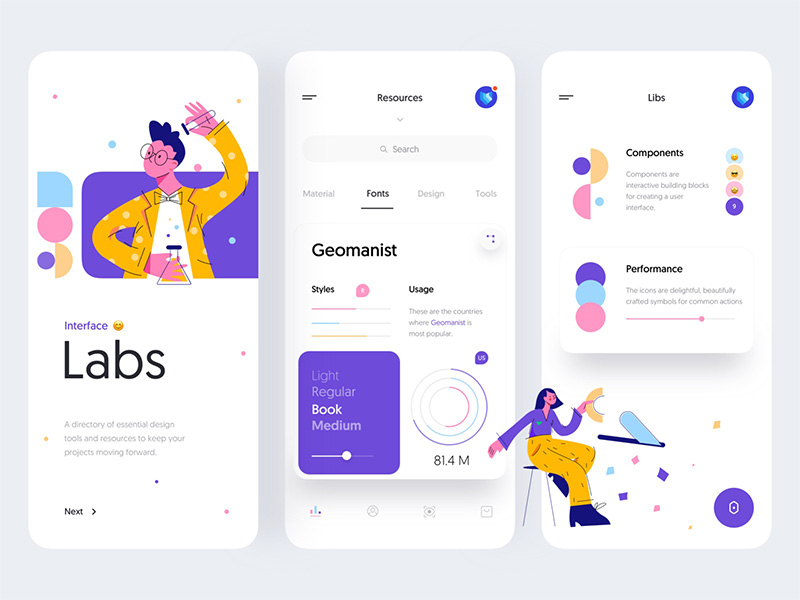
Mobile App Concept for UI Designers by Tran Mau Tri Tam
Design for efficiency
The ultimate goal of every design is to bring forth the ways a product could be of service to the user and highlight its features that contribute to reaching their objectives and dealing with the pain points. Educational apps are not an exception to this rule.
Structure information in a way that it could be easily reached which is vital for e-learning apps used by working professionals, like encyclopedias for interns and doctors. Otherwise, while being top-notch from the UI perspective, an app might lack efficiency resulting in people losing their time trying to make heads or tails of using your app, so they would be less likely to keep it on their phones and will sooner look for an analog made by your competitor who has taken it into account.
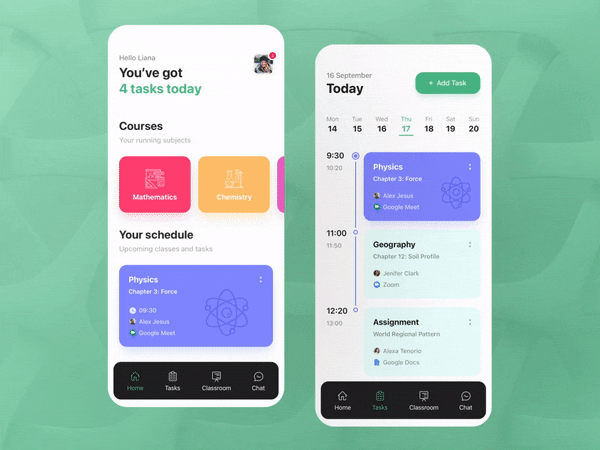
Study Management App Design | Task Management | Class Schedule by Rifat Sarkar
Design for a gaming experience
Traditional schooling is perceived as ineffective and boring by many students, even adult ones. Although teachers continuously seek novel instructional approaches, it is largely agreed that today’s schools face major problems around student motivation and engagement. Designers use gamification techniques to make e-learning apps more fun and enjoyable, even in an environment that at first glance may seem unsuitable for such an approach, like medical learning apps or apps about training employees to follow safety rules.
The majority of learning apps use challenges to add a sense of accomplishment. Some add scoreboards with the most prominent students. Another technique is adding points and providing levels to signify users’ performance success. In-game currency acts as a “payment” for benefits like extra lives.
Examples of such educational apps include Codecademy Go which is an app that lets you study coding. Students receive points for exercise completion, badges for grasping particular skills, and also features progress dashboards. The Khan Academy educational app gamifies the learning process by providing skill trees like RPG video games, badges, progress dashboards, and points.

Gamification Study – distance learning apps by Everton Curcio Martins
Design based on your competitors
There are many language learning apps available out there. Why is it that so many people use Duolingo? Well, because its users like it that it’s free, easy to use with different devices, has a thought-out UI and UX e-learning app design, and lets them see their progress which motivates them to keep on going. It’s the most well-known app in its category and its popularity is well-earned. However, there are always ways to improve anything in the world, the Duolingo app included.
Even designing an app for the subcategory where there are already a lot of popular apps, it’s possible to create something that would stand out. You can do it by learning from your competitors (and reviews on the products) and analyzing where they succeed and where they fall flat. It’ll help to keep your design consistent and show you the way to move ahead.

Guitar Learning App by Max Peschanskiy
In conclusion
Smartphones are not just handy tools that make our lives simpler letting us book tickets, order food and contact any person anywhere in the world in an instant, and all that on the go. They are also a medium that lets us receive and store information and knowledge. That’s why a smartphone has become a key tool in the educational process nowadays. E-learning apps are changing the way education works and e-learning app development companies are there to make this progress even more distinct. All you have to do is to adapt to these changes and pick the right education software company with the right kind of educational app development services.
Want to make an e-learning app with a unique design appealing to the audience so that people would relate to the project? We at Shakuro Agency will guide you every step of the way.
